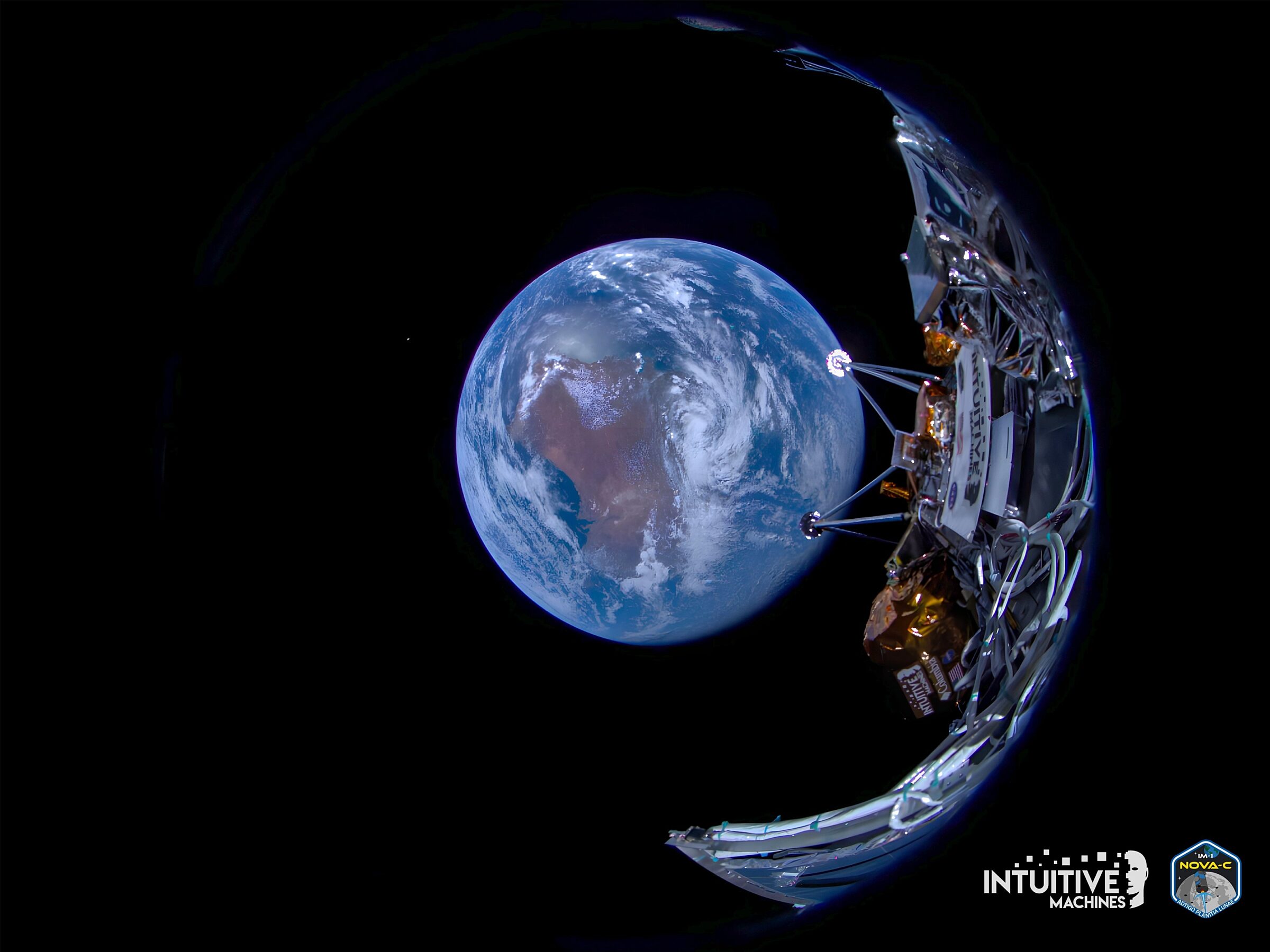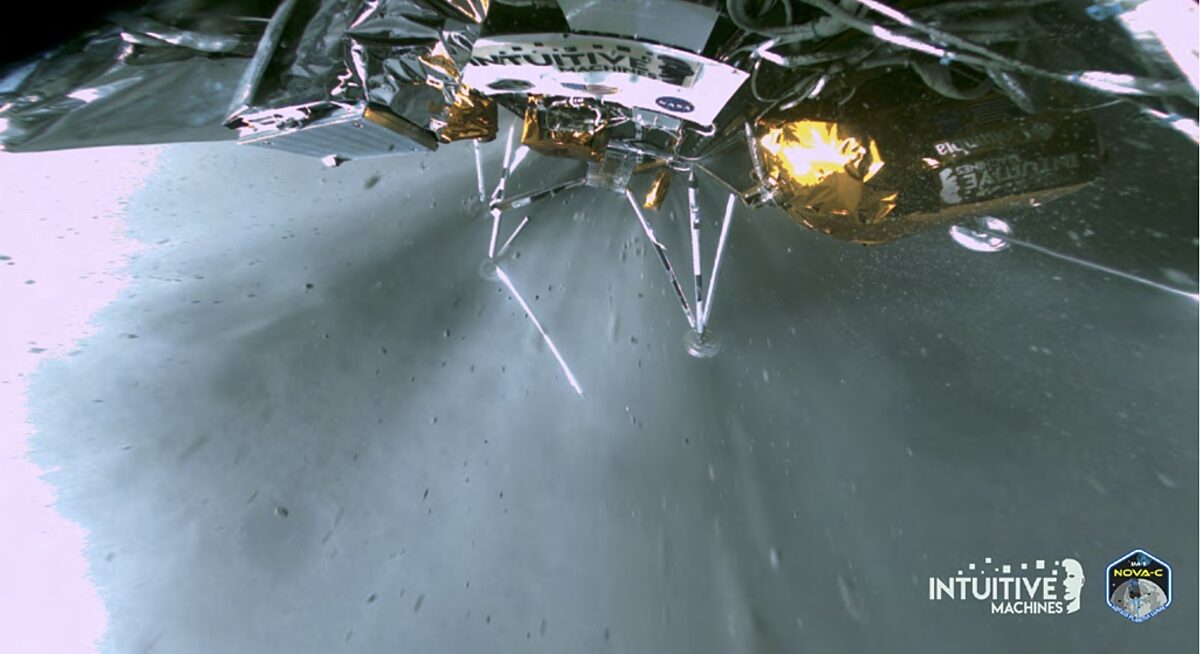CLPS: NASA's commercial Moon landing missions
What is NASA’s CLPS program?
NASA is funding a fleet of commercial robotic Moon missions as part of the agency's Artemis program.
With its $2.6 billion Commercial Lunar Payloads Services (CLPS) initiative, NASA is competitively financing commercial companies to build spacecraft that will carry science and technology payloads to the Moon on behalf of the space agency. The missions will advance our understanding of the lunar environment and help set the stage for a future human presence on the Moon.

Mission Overviews
For more information on each mission, scroll toward the bottom of the page.
Past CLPS missions
Astrobotic Technology, Inc.'s Peregrine Mission launched on Jan. 8, 2024. The spacecraft suffered a propellant leak, and it reentered Earth's atmosphere 10 days later.
CLPS missions in progress
Intuitive Machines, Inc.'s Nova-C Odysseus spacecraft landed on the Moon on Feb. 22, 2024 as part of the IM-1 mission.
Upcoming CLPS missions
Because of the dynamic nature of NASA's CLPS program, schedules and timelines change frequently.
2024
Intuitive Machines IM-2 will deliver the PRIME-1 drill to the lunar south pole.
Astrobotic will deliver NASA's VIPER mission to the lunar south pole.
Firefly Aerospace, Inc. will deliver its Blue Ghost lander to Mare Crisium, a dark patch located at the edge of the Moon's visible hemisphere as seen from Earth. The mission also includes Lunar PlanetVac, a technology funded in part by Planetary Society members and donors.
Intuitive Machines will send a mission to Reiner Gamma, a magnetic anomaly located on the lunar near side.
2025
The Charles Stark Draper Laborary, Inc. will deliver its SERIES-2 lander to Schrödinger Basin on the Moon's far side.
2026
Firefly will deliver two payloads to the lunar far side, along with a relay satellite built in collaboration with the European Space Agency.

The CLPS Program
Unlike traditional missions, CLPS missions are fully built, operated, and managed by their companies with minimal oversight from NASA. The agency only dictates preferences for the landing sites and the instruments it wants onboard.
These missions also have non-NASA payloads from across the globe — something the agency encourages to spur a commercial lunar ecosystem.
A new commercial model for planetary missions
Landing on the Moon is hard. Only four countries have accomplished this feat so far: the U.S., the Soviet Union, India, and China. The fact that NASA is entrusting commercial companies with the agency’s crucial lunar scientific and technological objectives, many of which will directly affect their Artemis plans, shows their growing confidence in building a commercial ecosystem around lunar exploration.

CLPS also inverts the tradition of having only custom-built planetary missions to meet specific scientific goals. If enough of the CLPS missions stick the landing, it would open up frequent and periodic access to the Moon’s surface for diverse scientific investigations in ways never possible before for any planetary body. NASA says future CLPS missions could also deliver more advanced rovers and technology demonstrations, and even infrastructure required by Artemis human landing missions.
Astrobotics’ first CLPS mission (Aborted)
Astrobotic's Peregrine Mission launched on Jan. 8, 2024 with the goal of delivering the Peregrine lander to the Moon’s near side. Peregrine was carrying a variety of payloads dedicated to studying the Moon, including rovers built by the U.S. and Mexico. However, Peregrine never made it to the Moon — the spacecraft suffered a propellant leak and was directed to reenter Earth's atmosphere on Jan. 18, 2024.
Intuitive Machines’ first CLPS mission (Completed)
The first mission by Intuitive Machines, or IM-1, sent the Odysseus lander to a landing site near the South Pole of the Moon. Odysseus touched down on Feb. 22, 2024 about a kilometer away from its intended landing site, becoming the first U.S. spacecraft to soft-land on the Moon in over 50 years. Problems with a laser navigation system, combined with difficult terrain, led the lander to tip onto its side as it made contact with the Moon’s surface. This limited Odysseus’ ability to communicate with Earth and perform its science objectives, but overall the mission was considered a success.
Intuitive Machines’ second CLPS mission
On its second Moon mission, Intuitive Machines will deliver NASA’s PRIME-1 drill and a mass spectrometer to the Moon’s south pole. The lander will drill up to 1 meter below the surface and analyze the soil for water ice, which will be the first demonstration of this sort of technology on the Moon to date. The lander will also deploy a rover on the surface to test Nokia’s 4G/LTE network on the Moon, another first. Further, there’s the company’s own NASA-supported hopper onboard called Micro-Nova, which will make rocket-powered jumps around the Moon while taking high-resolution images of the surface under its flight path.
VIPER rover delivery by Astrobotic
Astrobotic will deliver NASA’s VIPER rover to the Moon’s south pole. The rover will explore areas in and around permanently shadowed regions for about 100 days, using its drill and three other instruments to explore the Moon’s water ice deposits, assess their resource potential, and determine how accessible they are. This could help us plan future human missions to the Moon’s poles and eventually build sustainable habitats.

Firefly’s first CLPS mission
Firefly’s first Moon lander will descend in the lava plains of Mare Crisium, carrying several NASA instruments to study the lunar environment. One of the lander’s legs will feature PlanetVac, a low-cost soil sampling technology partially funded by The Planetary Society to enable future sample return missions from the Moon, Mars, and other planetary bodies. This mission will also be NASA’s first attempt to establish a GPS-like network around the Moon.
Intuitive Machines’ third CLPS mission
Intuitive Machines’ third Moon landing will be in the swirl of Reiner Gamma in 2024. Reiner Gamma has a weak local magnetic field, possibly a remnant from the time the Moon had a global magnetic field. The mission’s primary payload suite Lunar Vertex is a collection of lander instruments as well as a rover that, together, will study the swirl’s composition and map the surrounding magnetic field. This will help us better understand the Moon’s magnetic evolution and learn more about how the solar wind and bombarding micrometeorites can shape planetary bodies throughout the Solar System. The lander will also deploy four small CADRE rovers from NASA, which will autonomously navigate the landed site and map it more efficiently than a single rover would.
Draper’s farside CLPS mission
For its first CLPS mission in 2025, Draper will land a spacecraft on the Moon’s farside, a feat only achieved by China’s Chang’e 4 mission so far. The landing region chosen by NASA for the mission is no less impressive: the 312-kilometer-wide Schrödinger crater, the best preserved peak-ring basin on the Moon. The lander will carry 95 kilograms of NASA science instruments, which include two highly sensitive seismometers, a drill, a probe, and a magnetic sounder, all to help us better understand the Moon’s internal structure and how our cosmic neighbor evolved.
Firefly’s second CLPS mission
In its second mission to the Moon, Firefly will deliver a radio telescope and a communications terminal to the lunar far side. By looking out from the part of the Moon facing away from Earth, the telescope will be shielded from Earth transmissions and so better able to search for weaker radio signals like those from the early universe. Since that same shielding would prevent NASA from communicating with the spacecraft, Firefly will also be placing a relay satellite into lunar orbit.
Support missions like CLPS
Whether it's advocating, teaching, inspiring, or learning, you can do something for space, right now. Let's get to work.
Acknowledgments: This page was initially authored by Jatan Mehta.


 Explore Worlds
Explore Worlds Find Life
Find Life Defend Earth
Defend Earth


